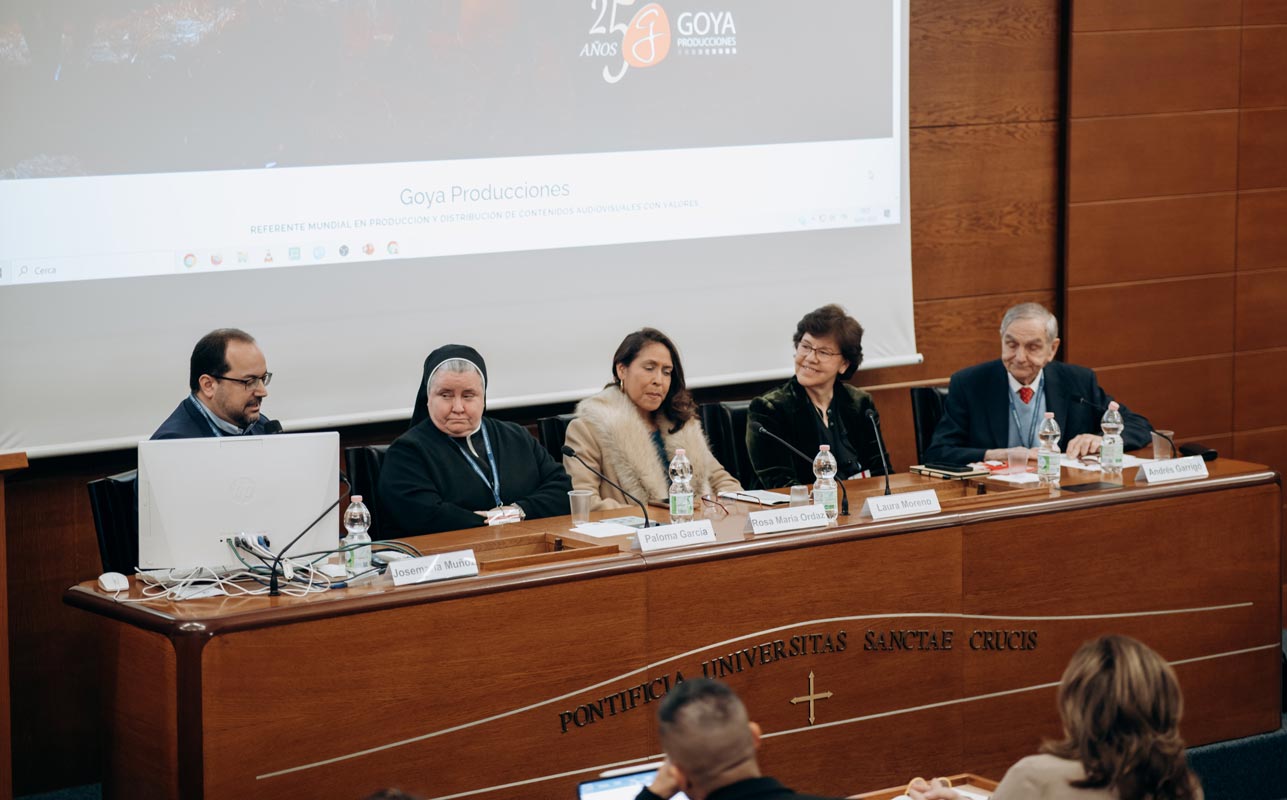
24 Apr Stories of Faith on the Screen
The round table titled “Stories of Faith on the Screen” featured Andrés Garrigó (founder of Goya Producciones), Paloma García (religious sister and promoter of the film Petra de San José), Josemaría Muñoz (executive producer at Goya Producciones), and Laura Moreno (from Institución Teresiana, promoter of the film Poveda). The discussion was moderated by Rosa María Ordaz, a journalist at Mundo Católico TV.
Rosa María Ordaz opened by highlighting cinema as a powerful tool for evangelization because of its ability to touch the heart deeply. She gave the example of films about the lives of saints:
“The saints give us a masterclass through their lives and show us with their testimony that when we unite everything adverse, painful, and heartbreaking in our lives to the cross, we find meaning, beauty, fruitfulness, splendor, intelligence, wisdom, and glory.”
Cinema, she said, can transmit this in a powerful way.
Andrés Garrigó spoke about the accidental birth of Goya Producciones 25 years ago, emphasizing how modern religious films have a similar impact today to that of saints’ biographies in the past:
“Nowadays, unfortunately, the masses no longer read many books, but they do watch movies. And if a film—like a saint’s biography—can open a path or awaken a vocation, then we truly have an extraordinary means of spreading the faith.”
He emphasized the importance of creating Catholic productions that can compete with major commercial films and reach mainstream audiences. He highlighted how the lives of lesser-known saints have been successfully brought to international audiences, citing examples such as Guadalupe and An Ardent Heart.
On bringing stories of faith to the screen, he noted:
“It’s a gift to the Church to be able to rescue from oblivion—which is sometimes a second death—those saints who are true beacons. They are the stars that light up the Church in times of darkness and serve as models of virtue.”
Mother Paloma García shared her experience producing Petra de San José, underscoring the value of cinema for religious congregations as a spiritual investment beyond any financial return:
“A film like Petra de San José yields many pastoral fruits. Right now, we have an incredible opportunity to work with laypeople and to share this with those we care for.”
She described the challenges of filming during the pandemic, and the pastoral fruits reaped afterward—especially among young people, who have shown great interest in well-made religious films:
“Young people don’t have filters—they tell you what they really think. And when they see a quality religious film, they say: ‘Hey, I actually liked it. I thought it would be boring, but it wasn’t.’”
Regarding the film’s theatrical release, she added:
“When you see your religious film in theaters competing with titles like Spiderman or Dune, you just think: ‘We need more films like this.’”
Laura Moreno spoke about Poveda, a film that portrays the life of Saint Pedro Poveda, emphasizing the saint’s social and educational mission within early 20th-century Spain. She highlighted how this production allowed for a unique encounter with the history and educational charisma of the founder of Institución Teresiana, becoming a valuable educational and evangelizing tool.
She commented on the film’s impact in various countries and the importance of telling stories that connect emotionally with viewers:
“Cinema is not just a communication tool—it’s a powerful tool of sensitivity that touches the heart because it comes from the heart of stories.”
A key aspect, she explained, is the script:
“When we felt called to make Poveda, we asked ourselves: can this be told through cinema? In the end, we made 35 versions of the script. It was a wonderful adventure.”
She added:
“A film like this leaves a mark—on the institutions promoting it, on the viewers, and on the filmmakers. We create a network of deep connections.”
That’s why, she said,
“It’s everyone’s responsibility to promote these stories. If we don’t promote them, there will never be better quality.”
Josemaría Muñoz addressed the practical and technical aspects of production and distribution:
“The creative process has three phases: script, shooting, and post-production. And in each of these phases, the film is made all over again. Sometimes you have to rewrite everything, always looking for ways to make the film dynamic and engaging.”
This process involves close collaboration with promoters and an unwavering commitment to artistic quality, casting, and final editing:
“From the beginning, our relationship with the institutions is essential,” he explained, “understanding what they want, then moving into the creative process—always thinking of the audience that will go to the theater.”
He also noted:
“Acting in religious films is challenging, especially since not all actors are believers. You have to explain the true meaning of the character so they can convey it convincingly on screen.”
He stressed the financial challenges of making such films and mentioned the digital platform Famiplay as a solution to the distribution difficulties posed by mainstream platforms like Netflix and Amazon Prime.
During the audience Q&A, questions arose about costs, distribution, and access to major streaming platforms. The speakers explained that although investments often exceed €400,000, there’s a strong providential and spiritual dimension that transcends mere economic logic. They also discussed the ideological and commercial barriers to entering mass platforms and stressed the importance of Catholic audiences supporting these initiatives from the moment of release.
Finally, Rosa María Ordaz concluded by emphasizing the need to trust in Divine Providence when undertaking evangelizing projects. She reiterated that part of the success lies in faith and perseverance. She added:
“I am convinced that when we go to see a film, it can become a contemplative setting, because its captivating content allows us to transcend hopeless realities and enter into spaces of ‘yes, it is possible’—not by our own strength, but because the protagonist inspires us and leads us to ignite sparks of light and hope.”

